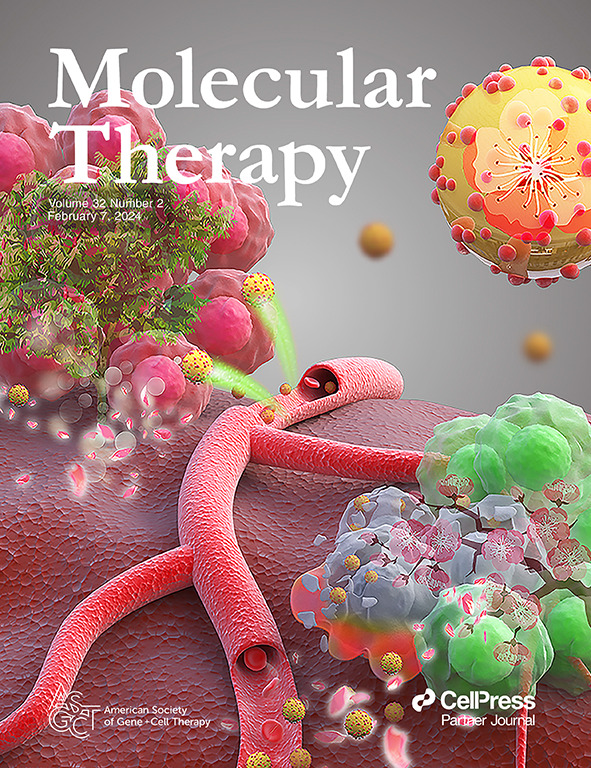Neuronal-targeted gene replacement rescues multiple phenotypes of STXBP1-related disorders in mice and is well-tolerated in nonhuman primates.
IF 12.1
1区 医学
Q1 BIOTECHNOLOGY & APPLIED MICROBIOLOGY
引用次数: 0
Abstract
De novo heterozygous variants in the neuronal STXBP1 gene cause severe, early-onset developmental and epileptic encephalopathy. Adeno-associated virus (AAV)-based gene replacement therapy offers the potential for a one-time, disease-modifying approach for STXBP1-related disorders. However, off-target overexpression in the liver and dorsal root ganglion (DRG) are known potential toxicities of AAV vectors. In addition, while loss of STXBP1 in GABAergic interneurons contributes to disease pathogenesis, typical gene therapy promoters do not express well in these cell populations. We engineered novel promoter cassettes to drive potent, selective STXBP1 expression across both excitatory and inhibitory neurons, and a 3'UTR regulatory element to detarget expression in DRG. Bilateral intracerebroventricular (ICV) injection of these promoter candidates achieved robust neuronal expression of STXBP1 and rescued key behavioral phenotypes in Stxbp1+/- haploinsufficient mice. In nonhuman primates, widespread vector biodistribution and transgene expression were observed in the central nervous system after unilateral ICV administration of AAV9-STXBP1 vectors. The vectors were well-tolerated, and addition of the detargeting regulatory element significantly reduced expression in DRG while ameliorating histopathologic effects and functional nerve conduction alterations. Taken together, these data support the feasibility of a one-time AAV-based therapeutic approach for STXBP1-related disorders.神经元靶向基因替代在小鼠中拯救了stxbp1相关疾病的多种表型,并且在非人灵长类动物中具有良好的耐受性。
神经元STXBP1基因的新杂合变异可导致严重的早发性发育性脑病和癫痫性脑病。基于腺相关病毒(AAV)的基因替代疗法为stxbp1相关疾病提供了一种一次性的疾病改善方法。然而,肝脏和背根神经节(DRG)中的脱靶过表达是已知的AAV载体的潜在毒性。此外,虽然gaba能中间神经元中STXBP1的缺失有助于疾病的发病,但典型的基因治疗启动子在这些细胞群中表达不佳。我们设计了一种新的启动子盒来驱动STXBP1在兴奋性和抑制性神经元中有效的、选择性的表达,并设计了一个3'UTR调控元件来脱靶DRG中的表达。在STXBP1 +/-单倍体不足的小鼠中,双侧脑室内注射这些候选启动子实现了STXBP1的稳健神经元表达,并挽救了关键的行为表型。在非人灵长类动物中,单侧ICV注射AAV9-STXBP1载体后,在中枢神经系统中观察到广泛的载体生物分布和转基因表达。载体耐受性良好,添加脱靶调控元件可显著降低DRG的表达,同时改善组织病理效应和功能性神经传导改变。综上所述,这些数据支持一次性基于aav治疗stxbp1相关疾病的可行性。
本文章由计算机程序翻译,如有差异,请以英文原文为准。
求助全文
约1分钟内获得全文
求助全文
来源期刊

Molecular Therapy
医学-生物工程与应用微生物
CiteScore
19.20
自引率
3.20%
发文量
357
审稿时长
3 months
期刊介绍:
Molecular Therapy is the leading journal for research in gene transfer, vector development, stem cell manipulation, and therapeutic interventions. It covers a broad spectrum of topics including genetic and acquired disease correction, vaccine development, pre-clinical validation, safety/efficacy studies, and clinical trials. With a focus on advancing genetics, medicine, and biotechnology, Molecular Therapy publishes peer-reviewed research, reviews, and commentaries to showcase the latest advancements in the field. With an impressive impact factor of 12.4 in 2022, it continues to attract top-tier contributions.
 求助内容:
求助内容: 应助结果提醒方式:
应助结果提醒方式:


